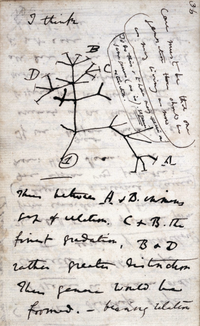
Photo from wikipedia
Wolbachia is a widespread endosymbiont of insects and filarial nematodes that profoundly influences host biology. Wolbachia has also been reported in rhizosphere hosts, where its diversity and function remain poorly… Click to show full abstract
Wolbachia is a widespread endosymbiont of insects and filarial nematodes that profoundly influences host biology. Wolbachia has also been reported in rhizosphere hosts, where its diversity and function remain poorly characterized. The discovery that plant-parasitic nematodes (PPNs) host Wolbachia strains with unknown roles is of interest evolutionarily, ecologically, and for agriculture as a potential target for developing new biological controls. The goal of this study was to screen communities for PPN endosymbionts and analyze genes and genomic patterns that might indicate their role. Genome assemblies revealed 1 out of 16 sampled sites had nematode communities hosting a Wolbachia strain, designated wTex, that has highly diverged as one of the early supergroup L strains. Genome features, gene repertoires, and absence of known genes for cytoplasmic incompatibility, riboflavin, biotin, and other biosynthetic functions placed wTex between mutualist C + D strains and reproductive parasite A + B strains. Functional terms enriched in group L included protoporphyrinogen IX, thiamine, lysine, fatty acid, and cellular amino acid biosynthesis, while dN/dS analysis suggested the strongest purifying selection on arginine and lysine metabolism, and vitamin B6, heme, and zinc ion binding, suggesting these as candidate roles in PPN Wolbachia. Higher dN/dS pathways between group L, wPni from aphids, wFol from springtails, and wCfeT from cat fleas suggested distinct functional changes characterizing these early Wolbachia host transitions. PPN Wolbachia had several putative horizontally transferred genes, including a lysine biosynthesis operon like that of the mitochondrial symbiont Midichloria, a spirochete-like thiamine synthesis operon shared only with wCfeT, an ATP/ADP carrier important in Rickettsia, and a eukaryote-like gene that may mediate plant systemic acquired resistance through the lysine-to-pipecolic acid system. The Discovery of group L-like variants from global rhizosphere databases suggests diverse PPN Wolbachia strains remain to be discovered. These findings support the hypothesis of plant-specialization as key to shaping early Wolbachia evolution and present new functional hypotheses, demonstrating promise for future genomics-based rhizosphere screens.
Journal Title: Frontiers in Microbiology
Year Published: 2022
Link to full text (if available)
Share on Social Media: Sign Up to like & get
recommendations!